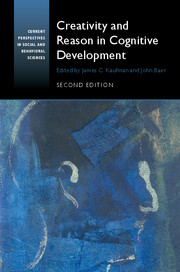Book contents
- Frontmatter
- Dedication
- Contents
- List of Contributors
- Acknowledgments
- 1 Creativity, Reason and Cognitive Development: Ten Years Later
- SECTION ONE CREATIVITY AND REASON IN CHILDHOOD AND THE SCHOOLS
- SECTION TWO CREATIVITY AND REASON IN COGNITION AND NEUROSCIENCE
- 8 The Role of Domain Knowledge in Creative Problem Solving
- 9 Processes, Strategies, and Knowledge in Creative Thought: Multiple Interacting Systems
- 10 Dynamic Processes within Associative Memory Stores: Piecing Together the Neural Basis of Creative Cognition
- 11 Creativity and Constraint: Friends, Not Foes
- 12 Creative Genius, Knowledge, and Reason: The Lives and Works of Eminent Creators
- 13 Attention, Cognitive Flexibility, and Creativity: Insights from the Brain
- SECTION THREE CREATIVITY AND REASON: INTERACTIONS AND RELATED CONSTRUCTS
- Author Index
- Subject Index
- References
11 - Creativity and Constraint: Friends, Not Foes
from SECTION TWO - CREATIVITY AND REASON IN COGNITION AND NEUROSCIENCE
Published online by Cambridge University Press: 05 February 2016
- Frontmatter
- Dedication
- Contents
- List of Contributors
- Acknowledgments
- 1 Creativity, Reason and Cognitive Development: Ten Years Later
- SECTION ONE CREATIVITY AND REASON IN CHILDHOOD AND THE SCHOOLS
- SECTION TWO CREATIVITY AND REASON IN COGNITION AND NEUROSCIENCE
- 8 The Role of Domain Knowledge in Creative Problem Solving
- 9 Processes, Strategies, and Knowledge in Creative Thought: Multiple Interacting Systems
- 10 Dynamic Processes within Associative Memory Stores: Piecing Together the Neural Basis of Creative Cognition
- 11 Creativity and Constraint: Friends, Not Foes
- 12 Creative Genius, Knowledge, and Reason: The Lives and Works of Eminent Creators
- 13 Attention, Cognitive Flexibility, and Creativity: Insights from the Brain
- SECTION THREE CREATIVITY AND REASON: INTERACTIONS AND RELATED CONSTRUCTS
- Author Index
- Subject Index
- References
Summary
The complex and sometimes elusive concept of creativity has inspired many creative approaches to its study. Despite competing accounts and progressively more methodical empirical scrutiny, creativity still seems surrounded by a fuzzy aura of ambiguity. Its very definition remains open to debate, and many other related issues risk to be buried under a similar state of inconclusiveness: Is creativity domain-specific or not (Ambrose, 2009; Baer, 1998, 2011, 2012; Silva, Kaufman, & Pertz, 2009)? Does it refer to a process, a set of aptitudes, or the resulting product? How is creativity assessed (e.g., Kaufman & Baer, 2012)? Is creativity restricted to only a few geniuses, or does creative potential exist in everyone? Does gender (e.g., Baer, 1997) or mental illness 2001 play a role (e.g., Kaufman, 2001)? Is creativity important (Kaufman, Davis, & Beghetto, 2012; Runco & Abdullah, 2014; Sternberg & Lubart, 1995)? If so, how does one best study it (Ambrose, 2006; Ambrose, Sriraman, & Pierce, 2014)? From a neuroimaging perspective (see Arden, Chavez, Grazioplene, & Jung, 2010 for an overview), how does creative thought develop in the brain, and where?
One of the less debated claims is that creativity can and does manifest itself in virtually all areas of human life. Creative instances range from a moving piano sonata to an original fashion show, from a major scientific breakthrough to witty dialogue in a novel, from an innovative business initiative to an inspired soccer game. Indeed, the adjective creative can precede a vast number of nouns: a creative experiment, creative architecture, a creative poem, creative landscaping.
Although creativity is often extolled in domains such as music, painting, and literature, few of us would readily associate it with more mundane tasks, such as making dinner or writing a note for someone's birthday. Why are we generally reluctant to apply the label creative to the production of an original meal or a sentence? The reason is a widespread intuition that “true” creativity must bring about, via its outcome, some major change or important contribution in an acknowledged field. For example, Sternberg, Kaufman, and Pretz (2002) put forth a Propulsion Theory of Creative Contributions to describe the processes by which a creative act can impact an entire field. Boden (1990) discussed this difference between two types of creativity: psychological (P-creativity) and historic (H-creativity).
- Type
- Chapter
- Information
- Creativity and Reason in Cognitive Development , pp. 211 - 225Publisher: Cambridge University PressPrint publication year: 2016
References
- 7
- Cited by

